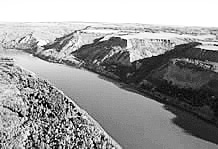Peace River Site C hydro project an option to help close B.C.’s growing electricity gap
Site C is a potential dam and hydroelectric generating station on the Peace River in northeastern British Columbia. It is one option being considered to help address British Columbia’s growing electricity gap.
A decision to proceed with Site C will only be made by the provincial government following extensive consultation and project evaluation. BC Hydro has developed a five-stage approach for evaluating Site C.
SITE C – At a Glance
• Third hydroelectric facility on the Peace River. By taking advantage of water stored upstream at the Williston Reservoir, Site C would be able to produce 1/3 the amount of electricity produced at the W.A.C. Bennett Dam with 1/20 the reservoir size.
• Dam: 60 metres high, 1,120 metres long (approximately 1/3 the height and 1/2 the length of the W.A.C. Bennett dam).
• Location: 83 kilometres downstream of Peace Canyon, seven kilometres southwest of Fort St. John, and 62 kilometres upstream from the Alberta border.
• Reservoir: Surface area of approximately 9,310 hectares.
• Generating station: six generating units with a total capacity of approximately 900 MW (about eight per cent of B.C.’s existing electricity demands). Average production of about 4,600 gigawatt hours of electricity each year (enough to power about 460,000 homes).
• Site C would provide a reliable, clean, and renewable source of electricity for more than 100 years.
SITE C – History 1950s to Present Day
• Survey work in the mid-1950s along the Peace River Canyon indicated the hydroelectric potential of the area. This led to the construction of the W.A.C. Bennett Dam and GM Shrum Generating Station, which began producing electricity in 1968.
• Additional work in 1958 identified five other locations – Sites A, B, C, D and E – near Fort St. John as potential locations for a third dam.
• In 1967, geographical and topographical work identified Sites C and E as the only viable options. In 1976, the current location of Site C was selected. However, development plans were shelved because there was no indication that a new resource option would be required for the foreseeable future.
• In 1982, BC Hydro submitted the Site C project to the British Columbia Utilities Commission (BCUC), which carried out a comprehensive review and consultation with stakeholders. BCUC concluded the project was viable, as long as identified impacts were managed. However, it recommended that Site C not be approved because electricity demand forecasts at the time did not warrant its development, and more analysis of alternatives was needed.
• In 1989, with the potential need for a new supply of electricity identified, Site C was revisited as an option. Two years of review and study was completed. In 1991, work was suspended as opportunities for demand-side management and gas-fired generation were identified as potentially better ways to meet demand.
• In its 2004 Integrated Electricity Plan, BC Hydro concluded that Site C should be considered a resource option. BC Hydro has since undertaken a feasibility review to review existing studies and historical information about the project.
• In the BC Energy Plan, the provincial government instructed BC Hydro to “enter into initial discussions with First Nations, the Province of Alberta and communities to discuss Site C.”
NEXT STEPS
• Large hydro projects require a long lead time. As such, BC Hydro has developed a five-stage approach for evaluating Site C. At the end of each stage, Site C will be evaluated against other resource alternatives available at that time before a decision is made on whether to proceed to the next stage of project evaluation.
• BC Hydro is currently in Stage 2 – Project Definition and Consultation, which is expected to take about two years to complete. This stage involves comprehensive consultation with communities, First Nations and stakeholders, as well as further updating and analysis of environmental, social, technical and economic factors impacting the project.
• As a first step in Stage 2, BC Hydro is engaging in a pre-consultation process to ask British Columbians how they want to be consulted and which topics they would like to discuss during Project Definition Consultation, which will begin in spring 2008.
• Pre-consultation input will be gathered through:
• Meetings with local, regional and provincial stakeholders;
• An online consultation discussion guide and feedback form at www.bchydro.com/sitec;
• Written submissions via mail or e-mail;
• A Community Consultation Office in Fort St. John (opening early 2008); and,
• Calls to the toll-free line.
• At the end of Stage 2, the provincial government and BC Hydro will decide whether to proceed to the third, regulatory stage for Site C.


 Follow
Follow



Recent Comments